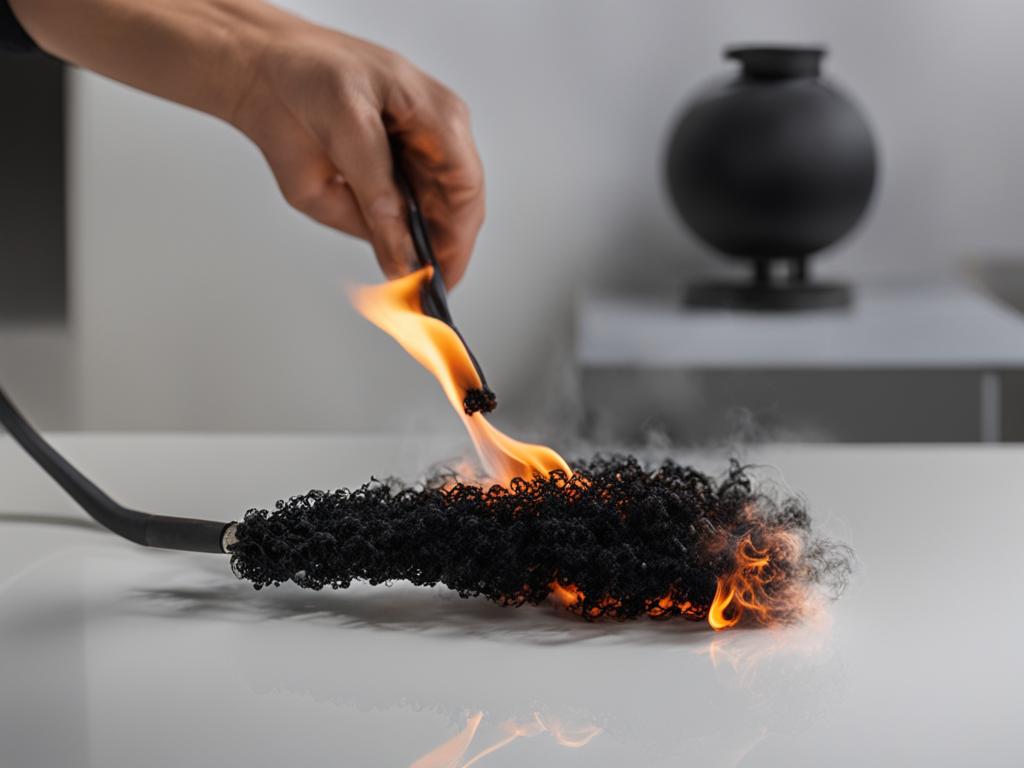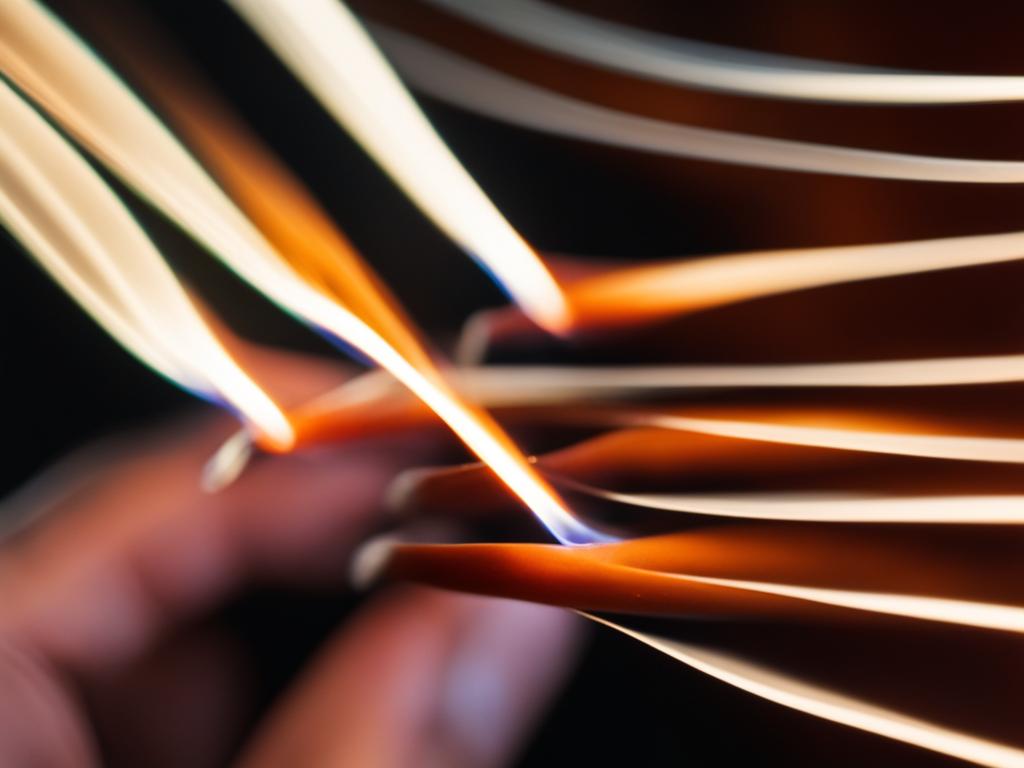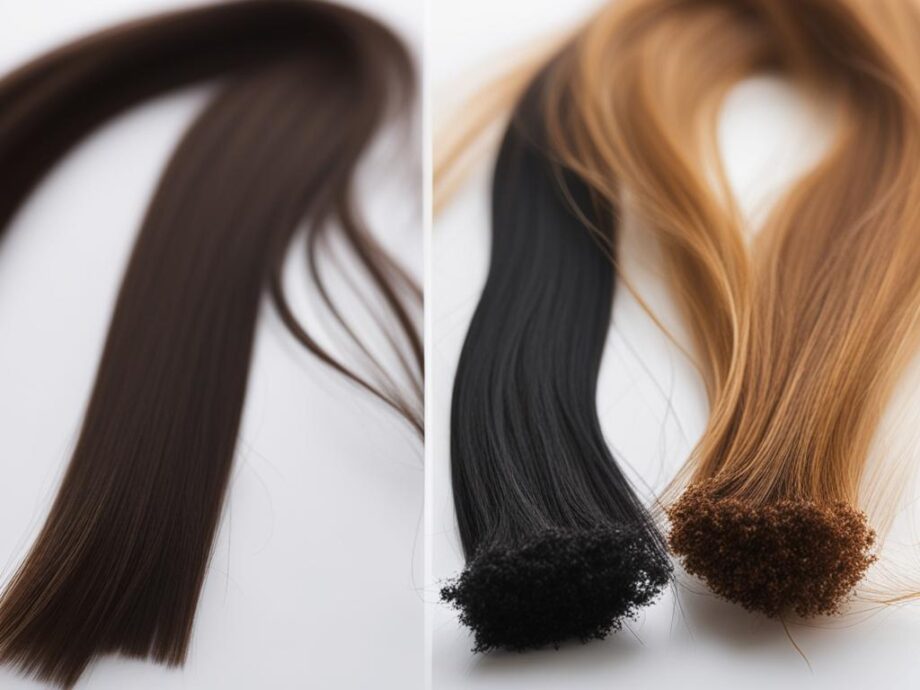In the world of hair extensions and wigs, it can be challenging to distinguish between human hair and synthetic hair. The type of hair you choose can significantly impact its durability, texture, and appearance. That’s where the burn test comes in – a simple and effective technique to determine the authenticity of hair strands.
In this comprehensive guide, we will explore the key differences between human hair and synthetic hair through the burn test. By understanding how each type of hair reacts when exposed to fire, you can confidently differentiate between real and artificial strands.
Key Takeaways:
- The burn test is a reliable technique for identifying whether hair is human or synthetic.
- Human hair and synthetic hair have unique characteristics that can be observed during the burn test.
- The burn test can be safely conducted at home with proper precautions.
- It is possible to further confirm the authenticity of hair through alternative identification methods.
- The type of hair you choose can significantly impact its durability, texture, and appearance.
The Importance of the Burn Test for Hair Identification
The burn test is a crucial technique for determining whether hair is real or synthetic. This method is especially useful for differentiating between human hair and artificial hair, allowing you to make informed decisions when buying or maintaining hair extensions or wigs.
By understanding the characteristics of the burn test, you can accurately identify the type of hair. Synthetic hair has unique properties that become apparent through a burn test, while human hair has different characteristics. The burn test provides a quick and reliable way to differentiate between the two.
Knowing whether hair is real or synthetic can help you style and care for it properly. Real human hair and high-quality synthetic hair can both be styled with heat; however, synthetic hair will melt if exposed to high temperatures, while human hair can withstand the heat. This means that you can use hot tools like curling irons and straighteners on human hair without melting or damaging the hair.
Identifying the type of hair you have also helps ensure you’re getting what you paid for. Some unscrupulous dealers may try to pass off synthetic hair as human hair, especially when selling wigs and extensions. With the burn test, you can verify whether the hair you’ve purchased is genuinely human hair or not.

In the next section, we’ll take a closer look at conducting a human hair burn test to determine whether hair is real or artificial.
Conducting a Human Hair Burn Test
Performing a human hair burn test is a simple yet effective way to differentiate between human hair and synthetic hair. To conduct this test, follow these steps:
- Prepare a small strand of hair sample from the hair you want to identify.
- Hold the hair sample with a pair of tweezers or pliers.
- Using a lighter or a matchstick, set the hair sample on fire.
- Observe the flame, smoke, and smell.
- Once the flame self-extinguishes, examine the residue left behind.
A genuine human hair sample usually burns slowly, producing a light, feathery gray ash, and emits a faint odor of burnt protein. In contrast, synthetic hair melts quickly, forming hard, black beads that are difficult to crush, releasing a distinct plastic-like smell. Refer to the table below for a visual comparison of the two burn tests.

Visual and Olfactory Indicators of Human Hair Burn Test
| Burn Test Indicator | Human Hair |
|---|---|
| Flame Appearance | Slow, consistent burn that dies on its own. |
| Ash Appearance | Light gray, feathery ash that is easy to crush or crumble. |
| Smell Appearance | A faint smell of burnt protein or human hair. |
Ensure that you conduct the human hair burn test in a safe and controlled environment to avoid risking any accidents.
Performing a Synthetic Hair Burn Test
If you have synthetic hair and want to verify its authenticity, you can perform a synthetic hair burn test.
Here are the necessary steps:
- Take a small portion of the hair, approximately six strands, and hold it with tweezers.
- Use a lighter or a match to burn the hair.
- Observe the synthesized hair strands as they burn, and take note of the smell.
- If the hair twists up as it burns and melts into hard balls, it is synthetic hair. Also, if the hair has a burning smell of rubber or plastic, it is synthetic.
Compared to human hair, synthetic hair has a distinct set of attributes while burning, which make it easy to separate one from the other.
Remember to perform the test in a safe environment. An alternative and safer method for checking your synthetic hair is to visit a professional hairdresser. They can carry out complementary tests to confirm the results.

Comparing Results: Human Hair vs Synthetic Hair Burn Test
After conducting the human hair burn test and synthetic hair burn test, it is essential to compare the results to differentiate between the two types of hair accurately. Comparing the burning patterns, smells, and residues is crucial to make an informed judgment when accessing hair authenticity.
| Human Hair Burn Test | Synthetic Hair Burn Test | |
|---|---|---|
| Burning Pattern | The human hair curls up into a ball after catching fire. | The synthetic hair melts and curls into tiny balls when on fire. |
| Smell | The human hair emits a burnt hair smell or the smell of singed protein fibers. | The synthetic hair has a sweet or plastic-like smell when it burns. |
| Residue | After burning human hair, there will be black, powdery ash left behind. | The synthetic hair leaves behind hard, black, plastic-like beads after burning. |
As seen in the table above, comparing the results of the burn test provides valuable insight into the differences between human and synthetic hair. These differences are important to note when determining the authenticity of hair.
It is crucial to keep in mind that while the burn test is a reliable method to distinguish between human and synthetic hair, it is not infallible. Always exercise caution when performing this test.
Additional Methods for Hair Identification
While the burn test is a trusted method for identifying human hair and synthetic hair, there are several alternative techniques that can also help determine hair authenticity.
Microscopy
Microscopic analysis of hair strands is a reliable method for determining if hair is human or synthetic. Human hair typically has a cuticle structure and a medulla, while synthetic hair strands are smooth and featureless. A trained technician using a microscope can examine the hair’s internal and external features and determine its authenticity with high accuracy.
Chemical Testing
Chemical tests such as the Melanin Test and the DNA Test can help in determining the origin of the hair. The Melanin Test determines whether the hair is from a human or animal source. In contrast, DNA testing is more expensive and time-consuming but can precisely determine the source of the hair and confirm the identity of the donor.
Price and Packaging
While it is not a foolproof method, the price and packaging of the hair product can often provide clues about the authenticity of the hair. Human hair is more expensive than synthetic hair, so if a product is being sold at a very low price, it is likely that it is synthetic. Authentic human hair products exhibit professional packaging and labeling with detailed information about the origin of the hair.
Conclusion
Undoubtedly, the burn test is a crucial tool for identifying whether hair is human or synthetic. It is imperative to understand the distinct burning characteristics of each hair type to make informed decisions while purchasing or maintaining hair extensions and wigs. By following the steps outlined in this guide, you can confidently perform a human hair versus synthetic hair burn test.
It’s essential to exercise caution and conduct the test in a secure environment, whether you’re performing the burn test to confirm the authenticity of hair you possess or hair you intend to purchase. Also, keep in mind that while the burn test is a reliable method, there are alternative techniques available to verify hair authenticity.
Overall, understanding the burn test and other hair identification methods empowers you to make the best decisions whenever you encounter a situation that requires hair confirmation. Thanks for reading our Human Hair vs Synthetic Hair Burn Test Guide!
FAQ
Why is the burn test important for identifying human hair and synthetic hair?
The burn test is crucial for hair identification as it helps differentiate between human hair and synthetic hair. By observing the characteristics during the burning process, such as smell and residue, one can determine the authenticity of the hair.
How do I perform a burn test on human hair?
To conduct a burn test on human hair, follow these steps: 1) Take a small strand of hair; 2) Hold it with a pair of tweezers or tongs; 3) Use a lighter or match to ignite the hair from the end; 4) Observe the flame, smell, and residue; and 5) Compare the results to known human hair burn test indicators.
What are the indicators of human hair during the burn test?
Human hair typically burns slowly, with a steady flame that smells like burnt hair. It will leave behind a light gray or white ash residue.
How can I perform a burn test on synthetic hair?
To conduct a burn test on synthetic hair, follow these steps: 1) Take a small strand of hair; 2) Hold it with a pair of tweezers or tongs; 3) Use a lighter or match to ignite the hair from the end; 4) Observe the flame, smell, and residue; and 5) Compare the results to known synthetic hair burn test indicators.
What are the indicators of synthetic hair during the burn test?
Synthetic hair typically melts, curls, or shrinks when exposed to heat. It may produce a flame and emit a chemical smell. The residue will harden into a ball or bead-like substance.
How can I compare the burn test results between human hair and synthetic hair?
By comparing the burning patterns, smells, and residue from the burn test, you can differentiate between human hair and synthetic hair. Human hair burns slower, smells like burnt hair, and leaves a light gray or white ash. Synthetic hair melts or curls, emits a chemical smell, and produces a hardened residue that resembles a ball or bead.
Are there any alternative methods for hair identification?
Yes, besides the burn test, there are alternative methods for identifying hair authenticity. These may include microscopic examination, chemical analysis, strand texture analysis, and professional consultations.
